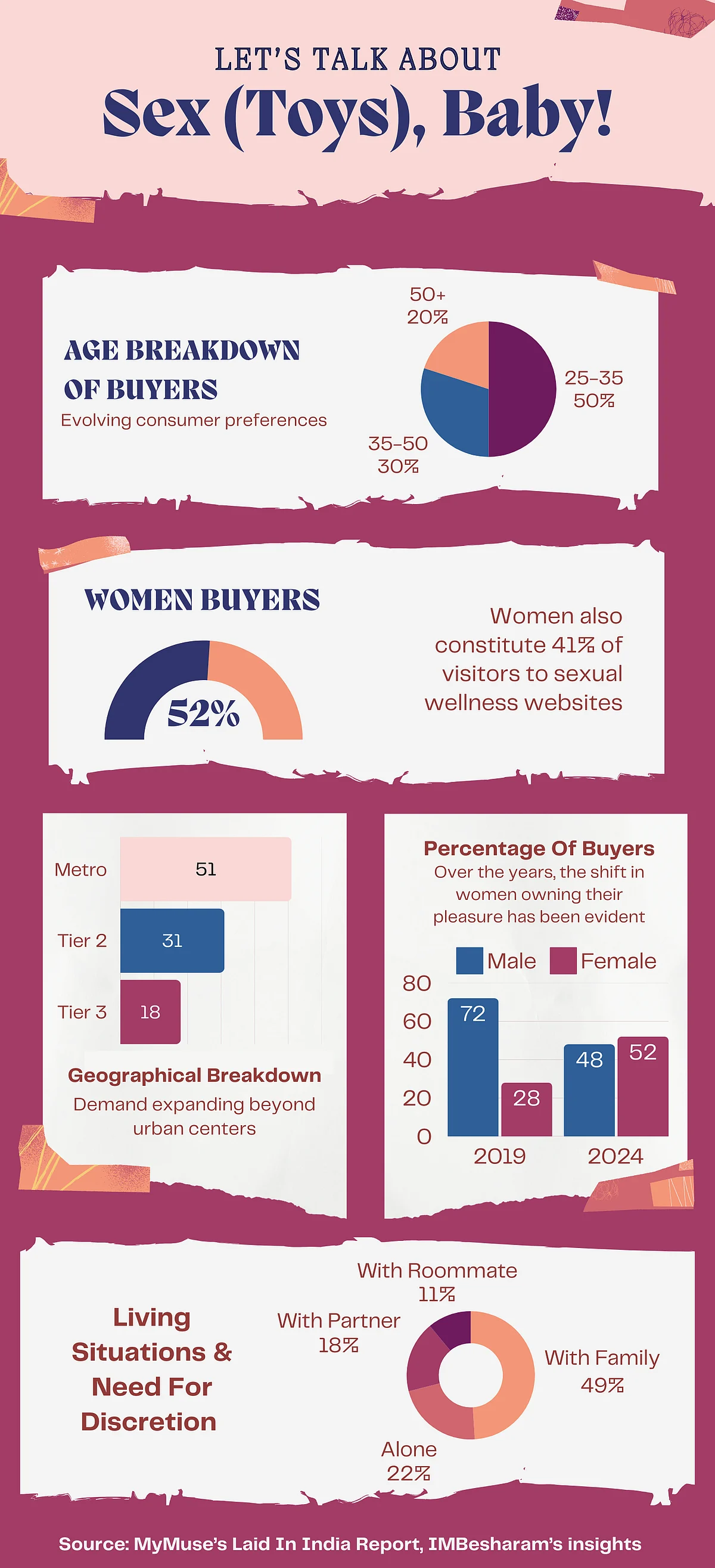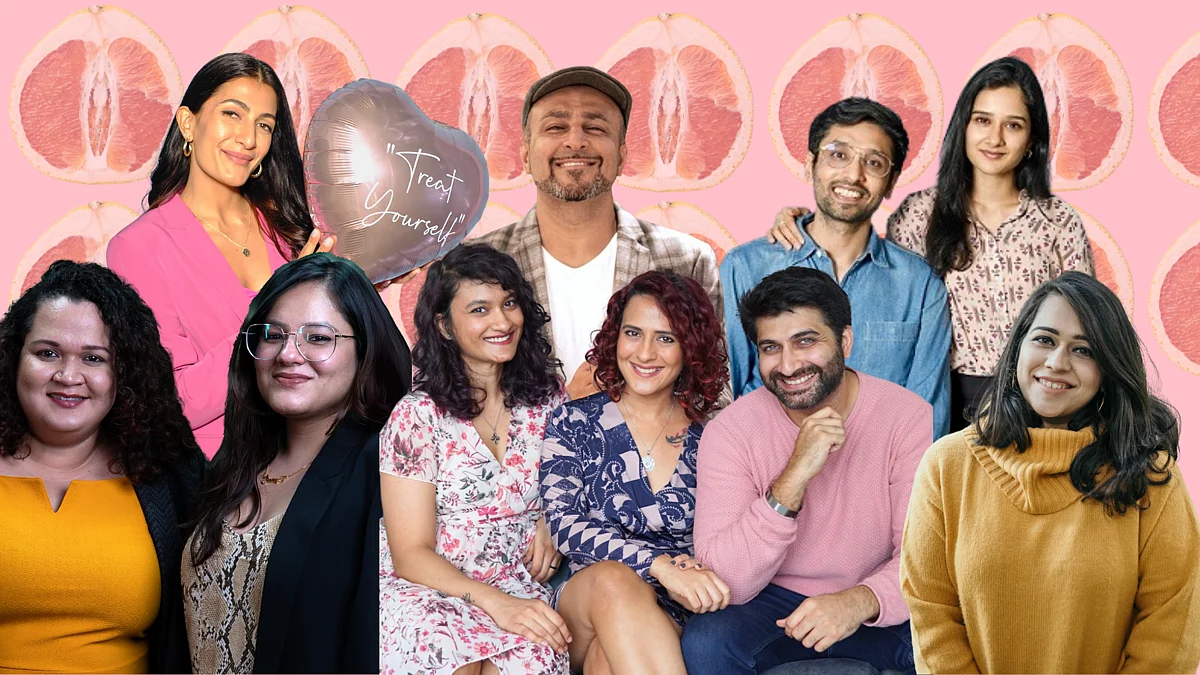The Great Indian Pleasure Boom Is More Than Just Good Vibes
India’s newest generation of sexual wellness brands are bold, innovative, attracting investments and turning profitable.

“People are ordering Maggi and massagers together on quick commerce apps—can you believe that? That’s the most surprising thing, but if you think deeper—it is extremely logical—both are midnight cravings!” says Sachee Malhotra, founder of That Sassy Thing, India’s first female-founded sexual wellness brand.
Remember when buying condoms at the pharmacy felt like a mission impossible? You’d avoid eye contact, mumble your order, and pray the cashier didn’t judge you. Fast forward to today—people are adding vibrators and lubes to their Zepto carts right next to peanut butter and protein bars.
For years, India’s sexual wellness industry operated in the shadows—silent demand, limited access, and hidden under layers of secrecy, and “Sharam nahi aati?” judgments.
A 2024 report by Grand View Research predicts that India’s sex toy market will cross $1 billion by 2030, growing at an annual rate of 9.9%. Meanwhile, TechSci Research estimated the industry at $91 million in FY2020, with a rapid 16% annual growth—making it one of the fastest-growing consumer segments in the country.
From quick commerce to homegrown brands designing India-specific products, the industry is not just expanding—it’s transforming how Indians approach pleasure.
Why should something as natural as pleasure still feel like a secret?Leeza Mangaldas, Founder of Leezu’s

From hush-hush to hot-selling, India’s pleasure economy is booming, and this is really just the beginning.
The Cultural Shift: From Forbidden To Front And Center
Think about it, sex education in schools was mostly a PowerPoint slide with an awkward silence. Raj Armani, founder of IMBesharam, one of India’s earliest dedicated sexual wellness platforms, mused, “India has always been a land of paradoxes—one of the largest consumers of porn, the birthplace of the Kamasutra, yet unable to discuss pleasure openly. We wanted to change that.”
According to the ‘Laid in India 2025’ report by MyMuse, which surveyed over 10,000 Indians:
87% do not wait until marriage to have sex.
78% are comfortable discussing sex toys with friends.
69% of women reported better orgasms with sex toys.
And it’s not just about sex. Pleasure is increasingly viewed as a wellness necessity.
“We’ve spent so much time talking about sexual health in terms of disease prevention—STDs, unwanted pregnancies—but what about sexual happiness?” asks Leeza Mangaldas, founder of Leezu’s.
Mangaldas also believes the shift is about breaking decades of conditioning, adding that ,”in India, for the longest time, pleasure was a privilege, not a right. That mindset is finally changing.”
But it’s not just women. Young men and couples are also leading the charge, with 36% of MyMuse’s buyers identifying as couples shopping together.
"I see so many of my guy friends gifting their girlfriends vibrators—it’s like the new ‘bare minimum’ boyfriend move," laughs Aarushi, 26, a Delhi-based marketing professional.
Brands have also flipped the script. Instead of "performance enhancement" ads targeted at men, the focus is now on education, comfort, and breaking stigmas.
“We want people to feel empowered, not embarrassed, when they shop for sexual wellness products. The more we talk about pleasure in an open, normal way, the less stigma remains,” says Anushka Gupta, co-founder of MyMuse.
Echoing this, Aishwarya Dua of Sassiest, a med-tech company merging pleasure and health, adds, “Marketing is about emotional connection. Apple doesn’t sell you an iPhone; they sell you a lifestyle. We’re doing the same thing—we’re not just selling vibrators, we’re selling confidence, self-care, and empowerment.”
Back in 2012, every time we spoke about sex or pleasure, the most common response was ‘Sharam nahi aati?Raj Armani, Founder of IMBesharam

The Indian founders at play. From L to R:
Top row: Leeza Mangaldas, Raj Armani, Sahil Gupta, Anushka Gupta.
Bottom row: Karishma Chavan, Aishwarya Dua, Tanisha RK, Shweta Sangtani and Aashish Mehrotra, Sachee Malhotra.
Desi Disruptors: Homegrown Brands Changing The Game
India’s newest generation of sexual wellness brands are bold, innovative, and unapologetically Indian—leaving behind the days of sketchy imports and uncomfortable shopping experiences.
“We started manufacturing in India because international products weren’t designed for Indian bodies. The torso-to-hip ratios of Caucasian and Southeast Asian bodies are different from ours. So we made something better,” says Shweta Sangtani, founder of Sangya Project, the first company to manufacture pleasure products locally.
And the strategy is paying off. Sangya Project has reported 12-13X growth since 2020, with a 30% revenue jump in just one month thanks to quick commerce sales.
Brands are getting smarter about product design. Armani says, “Even the end results of packaging are curated to what Indian audience seeks. Like not printing the name on the outside of the box, so that it can be used as a storage container for the toys.”
"We had a full-blown review session of vibrators at brunch once. The waiter was horrified, but we were having the time of our lives," says Ishita, 24, a Mumbai-based PR executive. According to MyMuse's data, over 50% of their first-time buyers are between 22-28 years old, showing that Gen-Z is leading this pleasure revolution.
Sex has always existed in India—our population proves that.Aishwarya Dua, Founder & CEO of Sassiest
Investors Are Taking Note
“Investment is pouring in—four brands raised over $5 million, three brought in celebrity co-founders, two went on Shark Tank, and one secured a $10 million Series A. This is just the beginning. India’s sexual wellness industry is in its golden era,” says Armani.
With quick commerce booming and local manufacturing scaling up, the profitability margins for sex toys are growing faster than ever.
MyMuse, launched in 2021, has achieved profitability, and Leezu’s has doubled their customer base since their launch in 2022. Malhotra also spoke about That Sassy Thing’s 300% year-on-year growth since their launch in 2021. Sassiest has seen a 300-400% year-on-year growth while being bootstrapped, with 70% of their revenue coming from quick commerce.
Armani also pointed out that the cumulative revenues of all brands in India in 2024, including marketplaces, ended over 200% compared to 2023, and 60% of this rise was due to one single factor - Introduction of pleasure products on Quick Comm marketplaces.
IMBesharam reported that quick commerce sales have grown 3x in the last year, with platforms like Blinkit and Zepto seeing repeat purchases increase by 60%. It also reports 54% of its revenue now comes from Tier 2 and Tier 3 cities, proving demand beyond metro cities is skyrocketing.
“We’re seeing a demand for more premium experiences—people aren’t just looking for basic massagers anymore. They want high-tech, app-connected, and sensory-enhancing products that match global standards,” says Mangaldas.
Male Pleasure: Underrated But Growing Market
While sex toys for women have gained widespread acceptance, male pleasure products are still breaking through barriers.
“A lot of men have been so exposed to porn that they don’t always approach pleasure with mindfulness. They think of it as something that needs to be rushed, performed, or proven,” says Mangaldas.
Men are buying more than ever—but quietly.
“It’s fascinating to see that when given the choice of anonymity and convenience, more men are willing to explore their pleasure without hesitation,” says Gupta. “Most of our male customers buy late at night and choose the ‘discreet packaging’ option,” adds Armani. He adds that they sell over 40% of toys for men, which accounts for 38% of their revenue.
“We’ve normalized vibrators, lubricants, and sexual wellness for women. Now, it’s time for men to realize that their pleasure matters too,” says Gupta.
It took a fight to create a product actually designed for vulva owners.Sachee Malhotra, Founder of That Sassy Thing
The ‘Made in India’ Movement & The Challenges Brands Face
While many sex toys sold in India are still imported, a shift toward locally-made products is underway. Homegrown brands are focusing on design, comfort, and inclusivity, ensuring that products cater specifically to Indian consumers.
“Our goal is to create a diverse catalog that meets people wherever they are in their sexual wellness journey. Whether they’re exploring for the first time or looking for something more advanced, we want them to find it with us,” says Sangtani.
But building ‘Made in India’ pleasure products isn’t easy.
The biggest roadblock for brands manufacturing in India has been convincing suppliers and factories to take them seriously. Sangtani points out that when Sangya Project started, “manufacturers wouldn’t even take our calls. Some packaging suppliers refused to work with us. Fast forward to today, and now they’re proactively reaching out—because they see the demand,” says Sangtani.
Malhotra also spoke about the lack of awareness, “Every manufacturer we spoke to kept suggesting we add ‘a little bit of fragrance’ or ‘a hint of flavor.’ It took a fight to create a product actually designed for vulva owners.”
Gupta adds that unlike beauty or wellness products, sex toy brands face significant barriers in advertising, “Even showing the product on Instagram can get our account restricted.” Since platforms like Google, Meta, and Instagram prohibit ads for "adult products," brands have relied on influencer marketing, organic reach, and direct-to-consumer strategies.
Affordability & Expanding Consumer Access
Let’s be real, high-quality sex toys are expensive. But brands have been actively working to make pleasure more affordable and accessible.
“The EMI option is a big part of our future growth strategy. We don’t want pleasure products to feel like a luxury purchase. If someone has ₹700 to spare per month, they should be able to afford a high-quality product without breaking the bank,” says Sangtani.
By offering payment plans, local manufacturing, and budget-friendly product lines, brands are ensuring more Indians can prioritize pleasure without financial strain.
Dua adds that 25-28% of Sassiest’s orders come from Tier 2 and Tier 3 cities, saying that “If you correlate it with the porn industry, those regions have the highest consumption in India—so the awareness is there, the money is there, but they don’t have access.”
There’s so much demand from Tier-II and Tier-III cities, showing that pleasure has no postcode.Anushka Gupta, Co-Founder of MyMuse
The First Purchase
Buying your first sex toy can feel overwhelming, but it doesn’t have to be. The key is to understand what you’re looking for—whether it’s solo pleasure, enhancing intimacy with a partner, or simply experimenting with something new.
According to Sangtani, “People often ask, ‘What’s the best sex toy?’ But there’s no universal answer. The right product depends on your comfort level, what you’re looking to explore, and how you define pleasure.”
Gupta encourages couples to make the process interactive, “Shopping with a partner can be fun—laugh at product names, read descriptions together, and enjoy the experience.”
We would like to meet people wherever they are in their sexual wellness journey.Shweta Sangtani, Founder of Sangya Project
What Comes Next For India’s Sex Toy Industry?
“We’re not just selling products—we’re changing the conversation. Five years ago, this industry barely existed. Five years from now, it’ll be impossible to ignore,” says Armani.
With investor funding, changing cultural attitudes, and homegrown innovation, it’s clear that pleasure is here to stay. Women are asking for better brands and better products, and men are understanding that toys don't replace them, they add to the experience.
As Sangtani succinctly put it, “We would like to meet people wherever they are in their sexual wellness journey. We want to be a place that has all sorts of functionality in their products. So if there is a functionality that we don't currently have, it is something that we want to work towards.”
So, the real question is, if Maggi can be a midnight essential, why not a massager?

